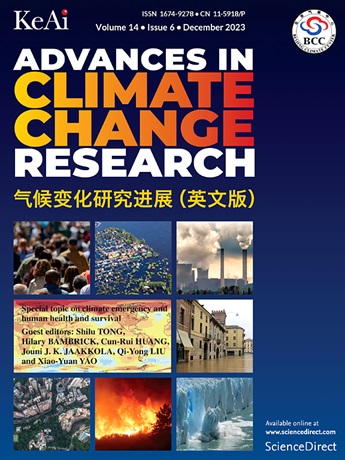由于最近的极端夏季火灾,黑碳在北极的辐射效应
IF 5.2
1区 地球科学
Q1 ENVIRONMENTAL SCIENCES
引用次数: 0
摘要
黑碳(BC)通过气溶胶-辐射-云相互作用和冰雪反照率反馈影响北极气候。近年来,火灾已成为北极BC的重要来源,而由于最近的极端火灾,BC在北极的辐射影响尚不清楚。基于数值模拟研究了2019年夏季极端火灾对北极地区BC的大气和雪辐射强迫,并探讨了其对气象变量和积雪反照率的影响。2019年夏季生物质燃烧BC在格陵兰岛和北冰洋中部大气底部造成负辐射强迫,在欧洲、西伯利亚中部和加拿大北部造成正辐射强迫,其值分别可达- 9 W/m2和18 W/m2。辐射强迫具有空间异质性,主要由与云变化相关的BC的半直接和间接辐射效应主导。北冰洋中部和格陵兰岛对流层高层气温升高,欧洲、西伯利亚中部和加拿大北部近地面气温升高。风场和相对湿度的响应主要与气温变化有关,在北极中部可观测到气旋活动异常。生物质燃烧导致格陵兰岛积雪正辐射强迫为0.4 ~ 1.4 W/m2,最大积雪反照率降低约0.005。总的来说,这项研究强调了火灾对北极气候的重要性。本文章由计算机程序翻译,如有差异,请以英文原文为准。
Radiative effects of black carbon in the Arctic due to recent extreme summer fires
Black carbon (BC) affects the Arctic climate via aerosol‒radiation‒cloud interaction and snow/ice albedo feedback. Fires have become a substantial source of the Arctic BC in recent years, while the radiative effects of BC in the Arctic due to the recent extreme fires remain unclear. In this study, the atmospheric and snow radiative forcing of BC in the Arctic due to the extreme fires in summer 2019 were investigated based on numerical simulations, and the effects on meteorological variables and snow albedo were explored. Biomass burning BC in summer 2019 caused negative radiative forcing at the bottom of the atmosphere in Greenland and the central Arctic Ocean, and it caused positive radiative forcing in Europe, central Siberia, and northern Canada, with values that can reach −9 W/m2 and 18 W/m2, respectively. The radiative forcing was spatially heterogeneous, which was mainly induced by the dominant role of semi-direct and indirect radiative effects of BC related to cloud changes. The air temperature in the higher troposphere increased in the central Arctic Ocean and Greenland, and the near-surface air temperature increased in Europe, central Siberia, and northern Canada. The responses of wind field and relative humidity were mainly linked with the air temperature changes, and the cyclone activity anomaly can be observed in the central Arctic. Biomass burning BC caused positive snow radiative forcing in Greenland of 0.4–1.4 W/m2, and the maximum snow albedo reduction was about 0.005. Overall, this study highlights the importance of BC from fires on the Arctic climate.
求助全文
通过发布文献求助,成功后即可免费获取论文全文。
去求助
来源期刊

Advances in Climate Change Research
Earth and Planetary Sciences-Atmospheric Science
CiteScore
9.80
自引率
4.10%
发文量
424
审稿时长
107 days
期刊介绍:
Advances in Climate Change Research publishes scientific research and analyses on climate change and the interactions of climate change with society. This journal encompasses basic science and economic, social, and policy research, including studies on mitigation and adaptation to climate change.
Advances in Climate Change Research attempts to promote research in climate change and provide an impetus for the application of research achievements in numerous aspects, such as socioeconomic sustainable development, responses to the adaptation and mitigation of climate change, diplomatic negotiations of climate and environment policies, and the protection and exploitation of natural resources.
 求助内容:
求助内容: 应助结果提醒方式:
应助结果提醒方式:


